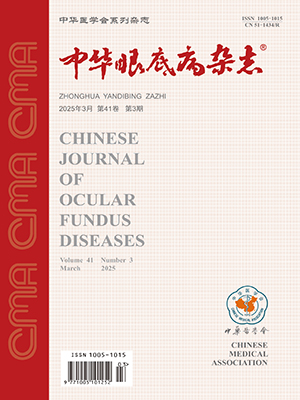Objective To observe the correlation between the thickness of foveal ganglion cell-inner plexiform layer (GCIPL) and visual field mean defect before and after gamma knife treatment in patients of sellar region tumors with optic chiasmal compression.
Methods This was a prospective case series. 72 eyes of 37 consecutive patients suffering from optic chiasmal compression of sellar region tumors treated with gamma knife were enrolled in the study. According to the change of visual field before and after gamma knife treatment, the patients were divided into three groups. There were 13 eyes of 7 patients in group 1 with no vision defect pre-and post-treated, 34 eyes of 17 patients in group 2 with improvement of visual field defect after treatment, 25 eyes of 13 patients in groups 3 with no improvement or reorganization of visual field defect after treatment. Overall average thickness of GCIPL, and of the superotemporal, superior, superonasal, inferonasal, inferior, and inferotemporal retina were measured with the Cirrus high-definition spectral domain optical coherence tomography, and mean deviation (MD) with the Humphrey field analyzer before and 6 months after treatment. There was no significant difference in MD values between group 2 and 3 pre-treated (t=1.471, P=0.084). There was significant difference between all the groups in total average value of GCIPL thickness and the 6 quadrant GCIPL thickness values pre-treated (P < 0.05). Logistic regression model was applied to analysis of the correlation between GCIPL thickness and the improvement of visual field after treatment.
Results The MD values of the group 1, 2 and 3 were (-2.96 ±0.75), (-10.24 ±1.31), (-20.2 ±5.88) dB at 6 months after treatment. There was significant difference between group 2 and 3 of MD value after treatment (t=6.974, P=0.000). In group 1, there was no significant difference in mean GCIPL thickness and the 6 quadrant GCIPL thickness values between pre-and post-treated (t=0.882, P=0.395).The mean thickness of GCIPL, superonasal and inferonasal GCIPL was increased than pre-treated in group 2, and the difference was statistically significant (t=2.438, 4.630, 4.457; P=0.035, 0.001, 0.001). The mean thickness of GCIPL, superonasal and inferonasal GCIPL was decreased than pre-treated in group 3, and the difference was statistically significant (t=-2.387, -4.603, -4.975; P=0.041, 0.002, 0.001).Logistic regression analysis showed that the greater of the value of average GCIPL thickness of patients with visual field defect pre-treated, the higher of the proportion of patients with improvement of visual field defect post-treated. There was a significant correlation between the value of superonasal or inferonasal GCIPL and the improvement of the visual field post-treated (OR=5.374, 4.693; P=0.000, 0.000). There was no significant correlation between the value of superotemporal or upper or lower or inferotemporal GCIPL and the improvement of the visual field post-treated (OR=1.058, 1.101, 1.074, 1.056; P=0.183, 0.080, 0.162, 0.186).
Conclusions In patients with optic chiasmal compression of sellar region tumor, the greater of the average GCIPL thickness pre-treated, the higher of the proportion of patients with improvement of visual field defect post-treated. There was a significant correlation between superonasal or inferonasal value of the GCIPL thickness and the improvement of visual field defect post-treated.
Citation:
LiMan, ChenXiaoming, LiNi, MouZhangbin, WangDongmei, XuBin. Correlations between the thickness of foveal ganglion cell-inner plexiform layer and visual field defect in patients of sellar region tumors with optic chiasmal compression before and after gamma knife treatment. Chinese Journal of Ocular Fundus Diseases, 2016, 32(6): 633-636. doi: 10.3760/cma.j.issn.1005-1015.2016.06.016
Copy
Copyright © the editorial department of Chinese Journal of Ocular Fundus Diseases of West China Medical Publisher. All rights reserved




